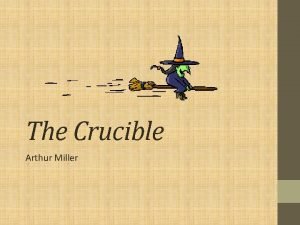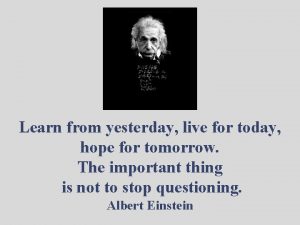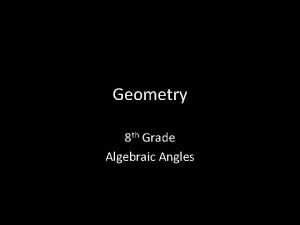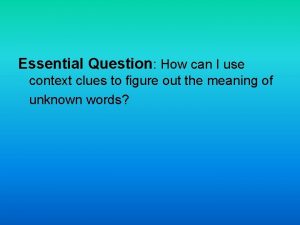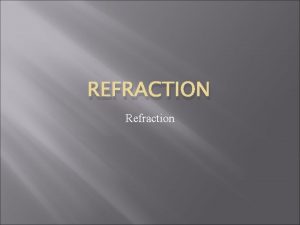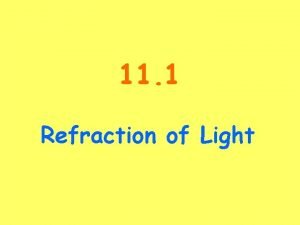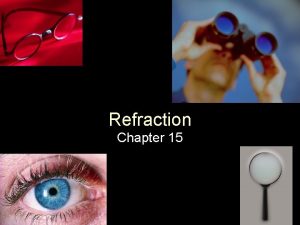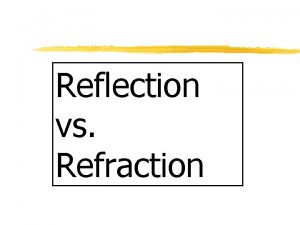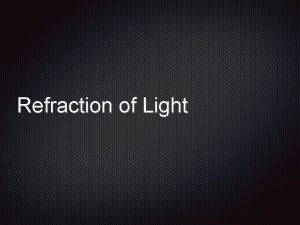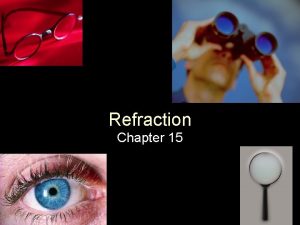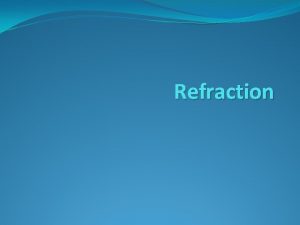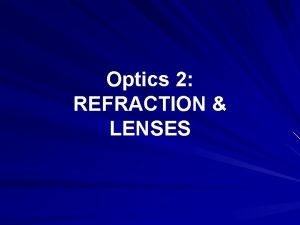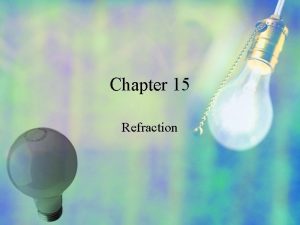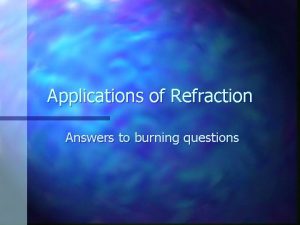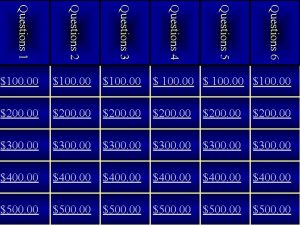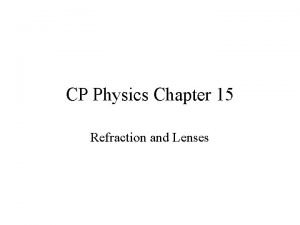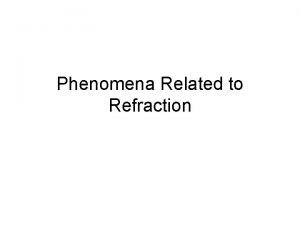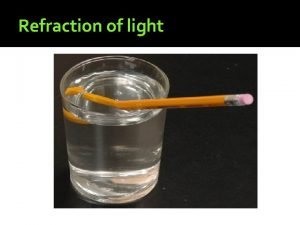Refraction Refraction Essential Questions What is refraction What


















- Slides: 18


Refraction

Refraction: Essential Questions • What is refraction? • What causes refraction? • What are some examples of refraction of light that show why it is important?

Refraction of Light - Defined • Refraction of light occurs when a light wave moves from a vacuum (or a medium) into another medium (or a vacuum). When a wave changes media, its ______ changes. • Unless the barrier between the media is perpendicular to the movement of the wave, the wave will change direction – that is REFRACTION

Refraction Illustrated


Refraction & Mirages

Refraction & Dispersion

Lenses: What do we want to know?

What do we want to know about lenses? Can we compute: f, di What affects f? What shape will produce real/virtual images? What shape do we used for near-sighted vs far -sighted? • What do near and far sighted mean? • •

Lenses

Lenses

Refraction & Lenses • What kind of lens can make a REAL image? (Concave or Convex) • Do lenses have a focal point? • What happens to the image distance as the object distance changes? – Perform an experiment that includes many measurements of object distance and image distance. Start with the object as close to the lens as it can be, while still having the image less than 1. 00 m from the object. Systematically increase the object distance, performing TEN trials. Every member must record the data in their notes!

Ray Diagrams for Convex (Converging) Lenses (Note: you only need 2 of the 3 rays) 1. From tip of object (an upright arrow sitting on the P. A. ), draw a ray that is parallel to the P. A. When it hits the lens, it refracts thru the (far) focal point 2. From the tip of the object, go straight thru the center of the lens w/o bending. 3. From the tip of the object, draw a ray thru the near focal point. When it hits the lens it refracts parallel to the P. A. 4. Where these three rays cross, position the tip if the arrow that represents the image. The tail of the arrow should touch the PA.

Convex Lenses & Ray Diagrams

The Thin Lens Equations 1/f = 1/do + 1/di M = hi/ho = -di/do f = focal length is dependent on curvature and n M = magnification do = object distance di = image distance is NEGATIVE when do < f and POSITIVE when do > f The image is real, inverted, and on the other side of the lens than the object when do > f The image is virtual, upright, & on same side of the lens as the object when do < f

Thin Lens Example: • A 2. 00 cm tall flame held 20. 0 cm from a thin convex lens projects a focused image on a screen that is 60. 0 cm from the lens. a) What is the focal length of the lens? b) What height is the image?

Determine the focal length of a convex lens. Objective: Materials Diagram: Data: Analysis: (ONE sample calculation & the mean computation) Conclusion:
 Plamatic acid
Plamatic acid Westward expansion discussion questions
Westward expansion discussion questions Figurative language essential questions
Figurative language essential questions Renaissance trade map
Renaissance trade map The pythagorean theorem
The pythagorean theorem French revolution essential questions
French revolution essential questions Enlightenment essential questions
Enlightenment essential questions Crucible essential questions
Crucible essential questions Persepolis book questions
Persepolis book questions Food web of yellowstone national park
Food web of yellowstone national park Non essential questions examples
Non essential questions examples Into the wild chapter 1 questions
Into the wild chapter 1 questions I am malala essential questions
I am malala essential questions Hamlet essential questions
Hamlet essential questions Essential questions for geometry
Essential questions for geometry Fences essential questions
Fences essential questions Stabilizing selection
Stabilizing selection Essential questions for context clues
Essential questions for context clues What is enduring understanding
What is enduring understanding







